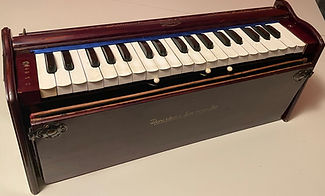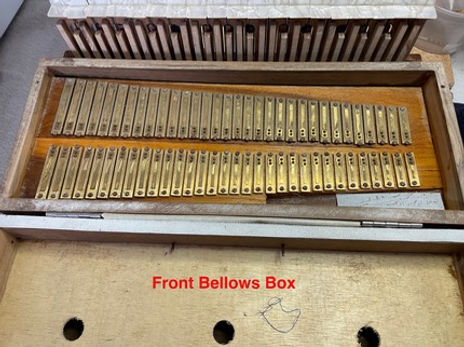Dulcetinas
The dulcetina is small and portable, but due to the small bellows and less than ideal spring force on the front reservoir bellows (which face the player), the sustain is not very good. Better for one or two note playing versus three or four note chords.
Here are two useful videos to help you work on a dulcetina:
Fixing misaligned keys
Disassembling a dulcetina
The picture on the right shows a dulcetina from the top. There are bellows on the back and one on the front. You pump the rear one. The front one is the air reservoir for the reeds. This serves the same function as the internal bellows on an Indian harmonium.

Dulcetina with no stops
The dulcetina in most of these pictures have two sets of reeds, but they cannot be individually controlled. There are no stops like on a harmonium.
Michael Ferris recently contacted me with information on dulcetinas with stops, that I didn't know existed. He sent me the pictures on the right.
The first picture shows the instrument with the back open showing the key springs and lifters.

One of Michael's dulcetinas showing the back side of the keyboard (on the bottom of the picture) and the key lifter for each key, with a right angle mechanism comment to dulcetinas
This second picture shows the two chambers with the reeds. Notice the board separating the two sets of reeds which is not present on the other dulcetina. This allows the stops to direct air to either or both sets of reeds.
In the tray below the reeds, there are three stops which are controlled by push/pull rods which pass through the top of the case. A knob is attached to the end of each of the rods, and bent so that the player presses down on the knob to stop the air flow to the associated reeds, or pull up on it to allow air to activate the air flow.
The tremolo stop is to the right of the other stops. When this stop is open (and the stop next to it is closed) a fluttering sound is created on the male reeds.

Front side of the dulcetina case showing the two sets of reeds and the two reed stops and the tremolo stop

Drone Stop (far right) Closed

All Stops Open
Back to the Instrument Without Stops
In this picture, the trim pieces above the keyboard have been removed.

This next picture shows the right side of the dulcetina with the side pieces removed and several parts identified. The keyboard sits on top of the main box where the front bellows are mounted with the reeds on the inside. It is hinged on the bottom and held closed by a metal latch on each side, as well as two Main Box screws on either side. This picture shows the Front Bellows Spring in the open position. The straight spring wire for the front belllows is shown resting against the box. There is a spring wire on either side of the front bellows which can be held in a latch (upper left of picture). Both springs should be latched to hold it closed during transport. However, these springs are quite strong and if both are engaged, the bellows will not move very much and the sustain will be very poor. With one spring disengaged the sustain is better, but with both springs disengaged, there is nothing but the folds of the bellows to squeeze air of the bellows.

Here is a right side view of the dulcetina with the side panel removed.
The Main Box holds the front bellows along with the reeds. There is a latch on each side used to hold the main box closed. This allows you to leave out the main box screws on either side while working on it.

With the Main Box screws removed and the latches opened, the keyboard and main box assembly can be hinged apart from the main bellows sub-assembly on the back. The key lifters which cover the reed holes are at 90 degrees to the keyboard and move towards the back of this picture when a key is pressed.

This picture is a rear view of the main box, with the rear cover laying flat. This exposes the key lifters and also shows the manifold for the main bellows and six small holes on the key lifter board, which channels the air into the reed chamber.

This picture is a view with the main box open, as seen from the opposite side of the reed and key lifter board relative to the picture above. The keyboard is vertical at the top of the picture for orientation. The open main box shows the reeds inside the box, and the front bellows (facing the player) on the other side. The three holes allow air to flow in and out of the front bellows, through the six holes in the above picture. which are covered by a trapezoidal piece of gray leather in the lower right corner under the reeds. This is a valve which controls the flow of air from the main bellows which are squeezed by the player, pressuring the reed box. The front bellows facing the player act as a reservoir. When the player finishes squeezing the main bellows and allows air to fill them, the valve closes so air is drawn from outside and not from the front bellows. In the more traditional harmonium, the bellows in the main case acts as the reservoir. The key lifters shown above are on the opposite side of the reeds...the rear of the main box.


